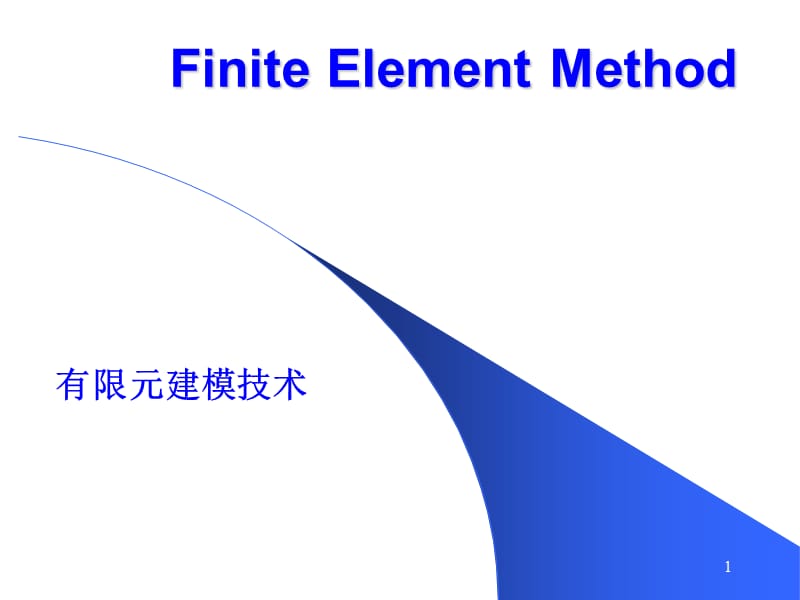《有限元程序設(shè)計(jì)-第九章有限元法中相關(guān)問(wèn)題的處理.ppt》由會(huì)員分享��,可在線閱讀�����,更多相關(guān)《有限元程序設(shè)計(jì)-第九章有限元法中相關(guān)問(wèn)題的處理.ppt(53頁(yè)珍藏版)》請(qǐng)?jiān)谘b配圖網(wǎng)上搜索�����。
1�����、1,Finite Element Method,有限元建模技術(shù),CHAPTER 11:,2,INTRODUCTION,保證有限元計(jì)算的結(jié)果可靠�����,穩(wěn)定 提高求解的精度和效率,,3,INTRODUCTION,需要考慮的主要因素: 計(jì)算量和計(jì)算規(guī)模的大?���?���; 明確需求和問(wèn)題的特點(diǎn)�����; 根據(jù)物理性質(zhì)和幾何特征選擇合理的單元配置���; 邊界條件的施加�����; 初始條件的加載。,4,CPU時(shí)間的估計(jì),,( ranges from 2 3),,Bandwidth, b, affects ,- 最小化帶寬值,Aim:,盡可能控制有限元建模的自由度的數(shù)目 單元密度的搭配,5,GEOMETRY MODELLING,對(duì)模型進(jìn)行適
2��、當(dāng)?shù)暮?jiǎn)化 3D? 2D? 1D? 或者混合單元形式,,(盡可能采用低維數(shù)單元),6,MESHING,在重點(diǎn)分析的局部布置較多的單元以增加精度�����;,,單元密度控制,7,Element distortion,單元會(huì)存在不規(guī)則的情況�,但是不能逾越有限元法的基本原理. The distortions are measured against the basic shape of the element Square Quadrilateral elements Isosceles triangle Triangle elements Cube Hexahedron elements Isosceles
3、tetrahedron Tetrahedron elements,8,Element distortion,單元的橫縱比,Rule of thumb:,9,Element distortion,角度的要求,10,Element distortion,曲率的要求,,11,Element distortion,對(duì)于面積和體積的要求,不能存在負(fù)面積�����,物理坐標(biāo)和自然坐標(biāo)之間的轉(zhuǎn)換,12,Element distortion,對(duì)于面積和體積的要求,13,Element distortion,中部節(jié)點(diǎn)位置,,可能導(dǎo)致應(yīng)力場(chǎng)的奇異,14,MESH COMPATIBILITY,最小勢(shì)能原理的要求 單元邊界的協(xié)
4、調(diào)性,15,不同階數(shù)的單元組合,,單元間隙��,造成應(yīng)力場(chǎng)的奇異,,,16,不同階數(shù)的單元組合,解決方式: Use same type of elements throughout Use transition elements Use MPC equations 多點(diǎn)約束方程,,,17,Straddling elements 跨界單元模式,避免跨界單元建模形式,18,USE OF SYMMETRY,不同類型的對(duì)稱:,,,,Mirror symmetry,Axial symmetry,Cyclic symmetry,Repetitive symmetry,Use of symmetry redu
5�、ces number of DOFs and hence computational time. Also reduces numerical error.,19,Mirror symmetry,特殊面的對(duì)稱形式,,20,Mirror symmetry,考慮二維問(wèn)題,如何施加約束:,u1x = 0,u2x = 0,u3x = 0,Single point constraints (SPC) 單點(diǎn)約束,21,Mirror symmetry,,Deflection = Free 法向偏移無(wú)約束 Rotation = 0 轉(zhuǎn)角為0,對(duì)稱加載,22,Mirror symmetry,Anti-symme
6�����、tric loading 反對(duì)稱加載,,Deflection = 0 偏移為0 Rotation = Free 轉(zhuǎn)角自由,23,Mirror symmetry,Symmetric 對(duì)稱 No translational displacement normal to symmetry plane(垂直于對(duì)稱面) No rotational components w.r.t. axis parallel to symmetry plane(平行于對(duì)稱面),24,Mirror symmetry,Anti-symmetric 反對(duì)稱 No translational displacement para
7�����、llel to symmetry plane No rotational components w.r.t. axis normal to symmetry plane,25,Mirror symmetry,Any load can be decomposed to a symmetric and an anti-symmetric load 任何加載可以分解為對(duì)稱和反對(duì)稱的組合,,26,Mirror symmetry,,27,Mirror symmetry,,,28,Mirror symmetry,Dynamic problems (e.g. two half models to get f
8���、ull set of eigenmodes in eigenvalue analysis) 動(dòng)態(tài)問(wèn)題(模態(tài)和特征值分析),,29,Axial symmetry,采用1D,2D軸對(duì)稱單元,,,Cylindrical shell using 1D axisymmetric elements,3D structure using 2D axisymmetric elements,30,Cyclic symmetry,,uAn = uBn,uAt = uBt,Multipoint constraints (MPC),31,Repetitive symmetry,,uAx = uBx,32,MODELL
9���、ING OF OFFSETS,,, offset can be safely ignored,,, offset needs to be modelled,,, ordinary beam, plate and shell elements should not be used. Use 2D or 3D solid elements.,Guidelines:,33,MODELLING OF OFFSETS,Three methods: Very stiff element 大剛性單元 Rigid element 剛體單元 MPC equations 多點(diǎn)約束方程,,,34,Creation
10、of MPC equations for offsets多點(diǎn)約束方程,,,,,,,,,,,Eliminate q1, q2, q3,,35,Creation of MPC equations for offsets,36,Creation of MPC equations for offfsets,d6 = d1 + d5 or d1 + d5 - d6 = 0 d7 = d2 - d4 or d2 - d4 - d7 = 0 d8 = d3 or d3 - d8 = 0 d9 = d5 or d5 - d9 = 0,37,MODELLING OF SUPPORTS,,
11����、38,MODELLING OF SUPPORTS,,(Prop support of beam),39,MODELLING OF JOINTS,,Perfect connection ensured here,40,MODELLING OF JOINTS,,Mismatch between DOFs of beams and 2D solid beam is free to rotate (rotation not transmitted to 2D solid),,Perfect connection by artificially extending beam into 2D solid
12、(Additional mass),41,MODELLING OF JOINTS,Using MPC equations,,,,,,42,MODELLING OF JOINTS,,Similar for plate connected to 3D solid,43,OTHER APPLICATIONS OF MPC EQUATIONS,Modelling of symmetric boundary conditions,,dn = 0,ui cos + vi sin=0 or ui+vi tan =0 for i=1, 2, 3,44,Enforcement of mesh compatib
13����、ility,,dx = 0.5(1-) d1 + 0.5(1+) d3,dy = 0.5(1-) d4 + 0.5(1+) d6,Substitute value of at node 3,0.5 d1 - d2 + 0.5 d3 =0,0.5 d4 - d5 + 0.5 d6 =0,Use lower order shape function to interpolate,45,Enforcement of mesh compatibility,Use shape function of longer element to interpolate,dx = -0.5 (1-) d1 + (1
14�����、+)(1-) d3 + 0.5 (1+) d5,Substituting the values of for the two additional nodes,d2 = 0.251.5 d1 + 1.50.5 d3 - 0.250.5 d5,d4 = -0.250.5 d1 + 0.51.5 d3 + 0.251.5 d5,46,Enforcement of mesh compatibility,In x direction,,0.375 d1 - d2 + 0.75 d3 - 0.125 d5 = 0,-0.125 d1 + 0.75 d3 - d4 + 0.375 d5 = 0,In y
15���、direction,,0.375 d6- d7+0.75 d8- 0.125 d10 = 0,-0.125 d6+0.75 d8 - d9 + 0.375 d10 = 0,47,Modelling of constraints by rigid body attachment,,d1 = q1 d2 = q1+q2 l1 d3=q1+q2 l2 d4=q1+q2 l3,(l2 /l1-1) d1 - ( l2 /l1) d2 + d3 = 0 (l3 /l1-1) d1 - ( l3 /l1) d2 + d4 = 0,Eliminate q1 and q2,(DOF in x directio
16、n not considered),48,IMPLEMENTATION OF MPC EQUATIONS,,,(Matrix form of MPC equations),(Global system equation),Constant matrices,,,49,Lagrange multiplier method,,,,,(Lagrange multipliers),Multiplied to MPC equations,Added to functional,The stationary condition requires the derivatives of p with resp
17���、ect to the Di and i to vanish.,,Matrix equation is solved,50,Lagrange multiplier method,Constraint equations are satisfied exactly Total number of unknowns is increased Expanded stiffness matrix is non-positive definite due to the presence of zero diagonal terms Efficiency of solving the system equa
18�、tions is lower,51,Penalty method,(Constrain equations),,=1 2 ... m is a diagonal matrix of penalty numbers,Stationary condition of the modified functional requires the derivatives of p with respect to the Di to vanish,,Penalty matrix,52,Penalty method,,Zienkiewicz et al., 2000 :, = constant (1/h)p+1
19��、,Characteristic size of element,,P is the order of element used,,,max (diagonal elements in the stiffness matrix),,or,Youngs modulus,53,Penalty method,The total number of unknowns is not changed. System equations generally behave well. The constraint equations can only be satisfied approximately. Right choice of may be ambiguous.,
 有限元程序設(shè)計(jì)-第九章有限元法中相關(guān)問(wèn)題的處理.ppt
有限元程序設(shè)計(jì)-第九章有限元法中相關(guān)問(wèn)題的處理.ppt

